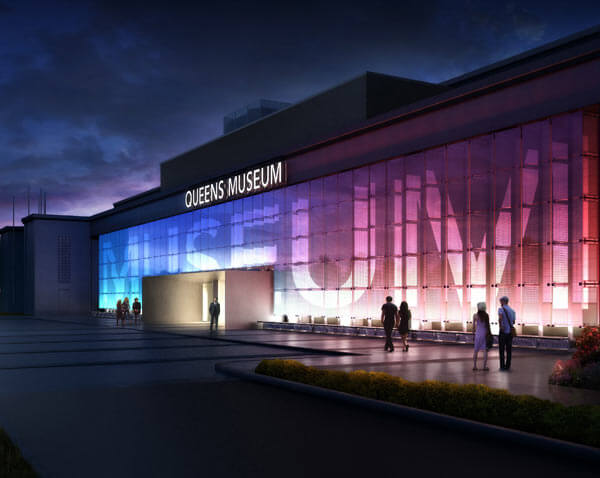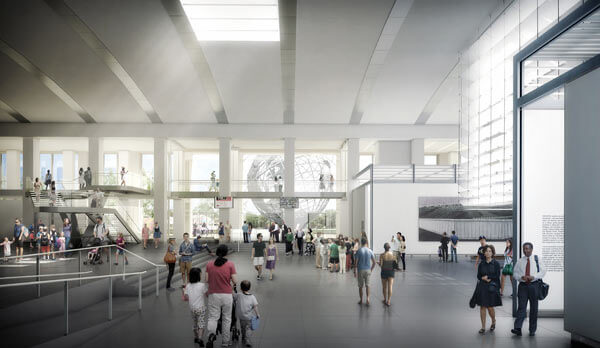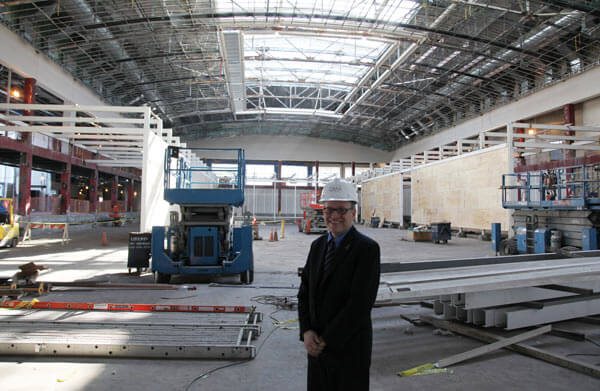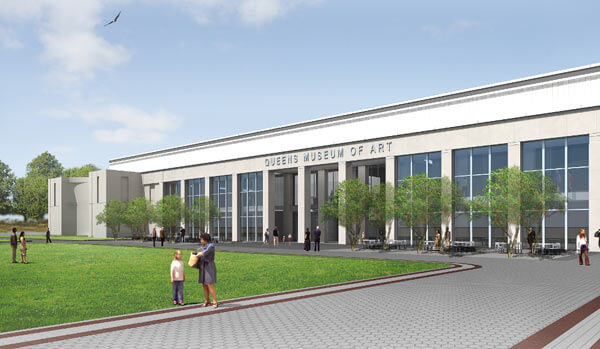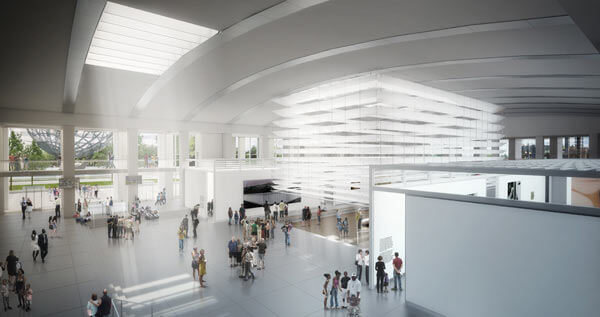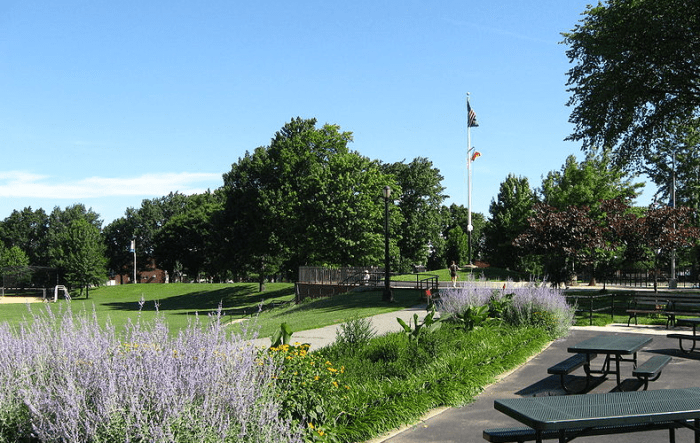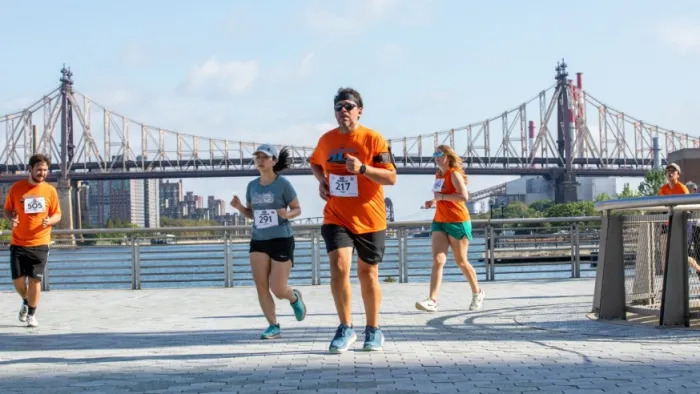By Tammy Scileppi
Reinvention is no easy feat — not even for a popular 35-year-old cultural landmark and local international art space nestled in Flushing Meadows Corona Park and only a stone’s throw from the Unisphere.
In the vastness of the busy, noisy construction site at the Queens Museum of Art, the work is going on at a steady pace, and it’s possible to visualize what the completed space will look like when it becomes a bustling hub, attracting thousands of visitors from the community, the city and beyond.
Queens Museum of Art Executive Director Tom Finkelpearl is the man behind the relaunching of his favorite museum since childhood. An historic, massive expansion project is now underway, which will double its size, while broadening its profile as, according to Mayor Michael Bloomberg, “a destination for New Yorkers and visitors to experience exciting exhibits and dynamic programs that reflect the creativity of New York’s largest and most diverse borough.”
Finkelpearl added, “The expansion will re-define a new moment in the museum’s history, but is also a symbol of QMA’s and the City’s dedication to giving the people of Queens that much more in cultural offerings.”
As an economic bonus, a revamped institution will bring more revenue into Queens and the city, and more jobs have been created during construction. But most importantly, the behemoth redesign will transform QMA into a centrally located recreational spot, where families can experience a variety of events, while enjoying all the museum has to offer — a place where kids can have fun while learning.
On April 12, 2011, a groundbreaking ceremony kicked off the expansion project, which will transform the museum into a premier multi-faceted venue, enhancing its geographic reach and re-energizing the park. The $68 million expansion will add 50,000 square feet of galleries, classrooms, public event spaces, a café and museum shop.
“The expanded outdoor lawn will have seating and more grassy areas for picnics,” said David Strauss, director of external affairs. “What better thing than for a museum to have a front yard like this with the Unisphere outside?”
The expansion gives QMA the entirety of the park’s New York City Building, originally built as the city’s official pavilion for the 1939 World’s Fair. Afterwards, it was converted into a recreation building — half used for the ice rink, the other half for a roller rink. It was also the original home of the United Nations General Assembly from 1946 to 1950 and is where the petitions of Palestine and North and South Korea were signed. It was also used as the city pavilion in the 1964 World’s Fair.
“Since the museum opened in 1972, we’ve been lusting after the other half of the building,” said Strauss. “When the city decided they were going to build a new rink and pool on the other side of the park, we were able to realize our dream, and brought in fantastic architects to work with us and design a great plan.” QMA teamed up with well-known British design firm, Grimshaw Architects. “We’re thrilled to have them onboard,” he said.
Sharing the limelight
It’s all about the power of teamwork and know-how. Arranging partnerships with Mayor Bloomberg, Queens Borough President Helen Marshall, City Council and board members, funders, artists and community leaders to make a vision a reality is one great example of what Finkelpearl does best. Then there’s global fund-raising. He was recently in Korea looking for opportunities in Korean engagement and funding.
“With everyone’s amazing support, we will be able to double our size and continue to present the museum’s unique mix of experimental public programs, innovative shows, and multi-faceted, multi-lingual education programs,” said Finkelpearl. “This has been a true public-private partnership.”
He indicated that while a city agency runs the construction project, he visits the site each day and oversees “the big picture,” leaving the day-to-day operations and details to Strauss.
Finkelpearl came on board in 2002 after 12 years as deputy director of the PS1 Contemporary Art Center in Long Island City. His family lived in Queens 100 years ago, in Rockaway and owned a hotel. He grew up in Massachusetts, but would visit Queens often.
On track for completion by the end of 2013, the museum is in full restructuring mode and the project’s key components are taking shape, already boasting what is sure to be one of its grandest features — a series of beautiful skylights, bathing the entire space with natural light.
“Very rarely are you going to see an institution with 60-foot soaring ceilings and natural light coming in,” said Strauss.
There’s also a brand new 220-foot glass façade and six new galleries, ranging in size from 900 sqare feet to 2200 square feet, which will allow for the displaying of large-scale temporary exhibitions. And that will free up space for original, current galleries to show their permanent collection.
“On the park side, near the Unisphere, the museum will have a new entryway. So they’re restoring the original access of the building. People can actually walk through the museum to get to the park,” Strauss said.
He also said that the city is the largest funder for the project. Over $21.5 million came from Marshall’s discretionary funds, a $15 million grant from New York state and considerable private funding.
“We’re happy to say that we’re fully funded. The silver lining in the economic downturn is that our project went out to bid when the economy was at its worst, so we were able to get more for our money,” said Strauss.
As a result of Finkelpearl’s vision and experience, QMA has undertaken significant community engagement initiatives, including a partnership with Queens Library. Queens Teens, a skill-building program for careers in the arts, and Dance in Queens — a dance residency program offering emerging choreographers and dancers practice and performance space, are among them.
“We not only care about the local area very deeply, but it goes beyond that as well — to the entire city,” said Finkelpearl. More than 250,000 visitors participate in QMA’s programs each year.
The expansion will also provide space for hosting weddings, ranging from 25-person to 1,500-person affairs.
The crown jewel of QMA, the Panorama of the City of New York, will remain where it is, and new entryways will allow visitors to easily access it from anywhere in the museum. The Neustadt Collection of Tiffany Glass will have a new gallery. There will be plenty of space for large-scale works.
“People love the Panorama — it’s a great asset. It dominates the whole museum, and school kids are constantly streaming in to see it,” said Finkelpearl, who describes himself as a contemporary art guy. “This was the first place I came to see when I would visit Queens. I would bring friends from out-of-town here.”

